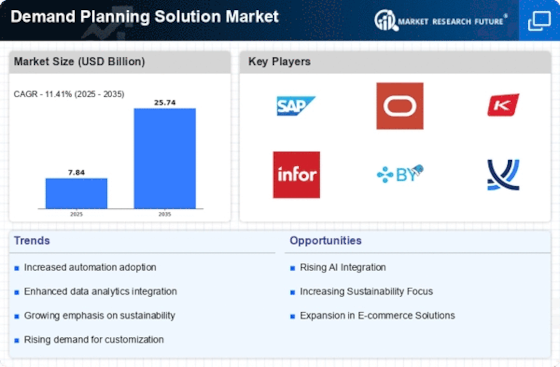The Demand Planning Solution Market is currently characterized by a dynamic competitive landscape, driven by the increasing need for businesses to enhance operational efficiency and responsiveness to market fluctuations. Key players such as SAP (DE), Oracle (US), and Kinaxis (CA) are at the forefront, each adopting distinct strategies to solidify their market positions. SAP (DE) emphasizes innovation through its cloud-based solutions, aiming to integrate advanced analytics and machine learning into its offerings. Oracle (US), on the other hand, focuses on expanding its suite of applications to provide comprehensive end-to-end supply chain solutions, thereby enhancing customer experience. Kinaxis (CA) leverages its RapidResponse platform to facilitate real-time decision-making, which is increasingly vital in today’s fast-paced market environment. Collectively, these strategies not only enhance individual company profiles but also intensify competition within the market, as firms strive to differentiate themselves through technological advancements and customer-centric approaches.
In terms of business tactics, companies are increasingly localizing their operations and optimizing supply chains to respond swiftly to regional demands. The market structure appears moderately fragmented, with a mix of established players and emerging startups vying for market share. This fragmentation allows for diverse offerings, yet the influence of major players like SAP (DE) and Oracle (US) remains substantial, as they set benchmarks for innovation and service delivery that smaller firms often aspire to emulate.
In August 2025, SAP (DE) announced a strategic partnership with a leading AI firm to enhance its predictive analytics capabilities. This collaboration is poised to significantly improve demand forecasting accuracy, enabling clients to make more informed decisions. The integration of AI into SAP’s existing solutions may not only streamline operations but also provide a competitive edge in a market where data-driven insights are paramount.
Similarly, in September 2025, Oracle (US) launched a new version of its cloud-based demand planning software, incorporating advanced machine learning algorithms. This update is expected to enhance the software's ability to analyze vast datasets, thereby improving demand visibility and responsiveness. By continuously evolving its product offerings, Oracle (US) reinforces its commitment to innovation, which is crucial for maintaining relevance in a rapidly changing market.
In October 2025, Kinaxis (CA) unveiled a new feature within its RapidResponse platform that allows for enhanced collaboration among supply chain partners. This development is particularly significant as it addresses the growing need for integrated supply chain solutions that facilitate real-time communication and data sharing. By fostering collaboration, Kinaxis (CA) positions itself as a leader in creating agile supply chain ecosystems, which are increasingly vital for businesses aiming to thrive in a competitive landscape.
As of October 2025, the Demand Planning Solution Market is witnessing trends that emphasize digitalization, sustainability, and the integration of artificial intelligence. Strategic alliances are becoming more prevalent, as companies recognize the value of collaboration in enhancing their technological capabilities and market reach. Looking ahead, competitive differentiation is likely to evolve from traditional price-based strategies to a focus on innovation, technological integration, and supply chain reliability. This shift underscores the importance of adaptability and forward-thinking in navigating the complexities of the modern market.


















Leave a Comment